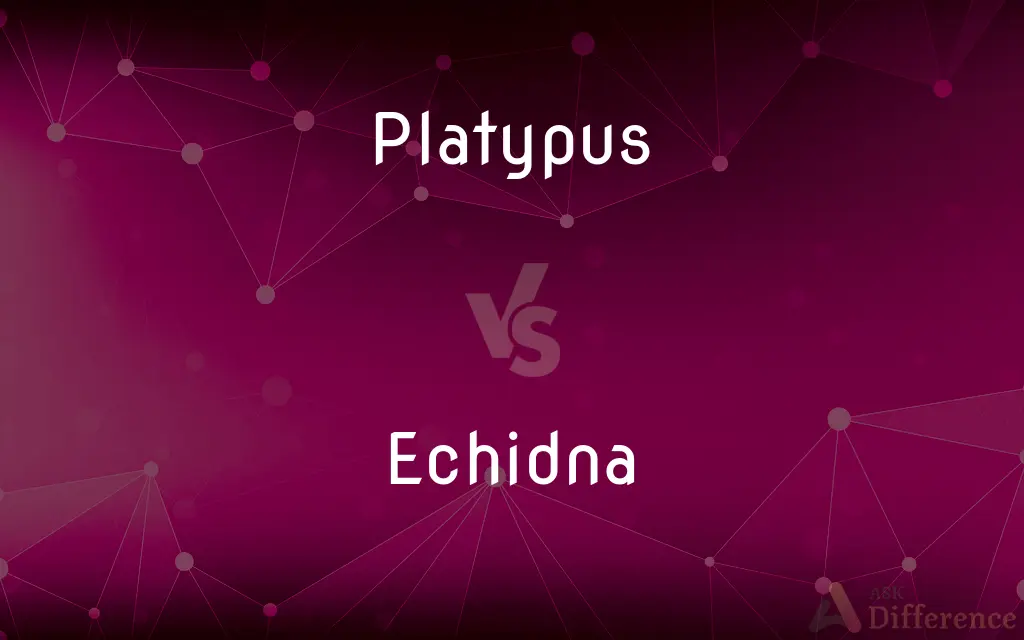Platypus vs. Echidna — What's the Difference?
Edited by Tayyaba Rehman — By Fiza Rafique — Published on November 24, 2023
Platypus is a semi-aquatic mammal with webbed feet and a duck-bill, while Echidna is a spiny terrestrial mammal with a long snout.

Difference Between Platypus and Echidna
Table of Contents
ADVERTISEMENT
Key Differences
Platypus and Echidna are both unique mammals native to Australia. The Platypus is easily distinguishable by its duck-bill and webbed feet, making it suited for a semi-aquatic environment. In contrast, the Echidna possesses spines much like a hedgehog and uses its long snout to feed on ants and termites.
Habitats differ for these creatures; the Platypus typically lives near freshwater lakes or streams, spending much of its time in water. The Echidna, however, prefers terrestrial habitats, from deserts to forests.
When it comes to reproduction, both the Platypus and Echidna are egg-laying mammals, known as monotremes. However, the Platypus lays its eggs in burrows alongside riverbanks, while the Echidna buries them in pouches on its belly.
One of the most striking differences is in their defense mechanisms. The male Platypus has venomous spurs on its hind legs, which can deliver a painful sting, while the Echidna relies on its spines to deter predators.
In terms of diet, the Platypus is carnivorous, feeding primarily on crustaceans, insect larvae, and worms. The Echidna, on the other hand, mainly eats ants and termites using its sticky tongue to capture its prey.
ADVERTISEMENT
Comparison Chart
Habitat
Semi-aquatic, lives near freshwater lakes or streams.
Terrestrial, varies from deserts to forests.
Physical Features
Duck-bill and webbed feet.
Spines and long snout.
Reproduction
Lays eggs in burrows alongside riverbanks.
Lays eggs in pouches on its belly.
Defense Mechanism
Male has venomous spurs on hind legs.
Relies on its spines.
Diet
Carnivorous, eats crustaceans, insect larvae, and worms.
Ants and termites.
Compare with Definitions
Platypus
A semi-aquatic mammal native to Australia with a distinct duck-bill.
The Platypus is one of the few mammals that lays eggs.
Echidna
An insectivorous mammal primarily feeding on ants and termites.
The diet of the Echidna consists mainly of ants and termites.
Platypus
A species possessing a venomous spur on its hind leg (in males).
The male Platypus's venomous spur can deliver a painful sting.
Echidna
A terrestrial creature known for its distinct long snout.
The Echidna used its snout to probe the ground, searching for ants.
Platypus
A carnivorous creature with webbed feet suitable for swimming.
The Platypus dived into the water, searching for its next meal.
Echidna
A spiny, egg-laying mammal native to Australia and New Guinea.
The Echidna is sometimes called the spiny anteater due to its diet.
Platypus
An egg-laying mammal belonging to the monotreme group.
Unlike most mammals, the Platypus reproduces by laying eggs.
Echidna
A member of the monotreme group, laying eggs rather than giving birth to live young.
Like the Platypus, the Echidna is a monotreme, laying eggs for reproduction.
Platypus
A unique mammal equipped with electroreceptors to detect prey.
Using its electroreceptors, the Platypus can locate prey underwater.
Echidna
A slow-moving creature, relying on its spines for protection against predators.
When threatened, the Echidna curls into a ball, showcasing its protective spines.
Platypus
A semiaquatic egg-laying mammal (Ornithorhynchus anatinus) of eastern Australia and Tasmania, having a broad flat tail, webbed feet, a snout resembling a duck's bill, and in the male, venomous spurs on the hind legs. Also called duckbill, duck-billed platypus.
Echidna
Any of several nocturnal burrowing egg-laying mammals of the genera Tachyglossus and Zaglossus of Australia, Tasmania, and New Guinea, having a spiny coat, a slender snout, and an extensible sticky tongue used for catching insects.Also called spiny anteater.
Platypus
A semi-aquatic, egg-laying monotreme mammal with a bill resembling that of a duck, that has a mole-like body, a tail resembling that of a beaver, a waterproof pelt, and flat webbed feet — males have poisonous spurs on the inside of the back legs; Ornithorhynchus anatinus
Echidna
Any of the species of small spined monotremes in family Tachyglossidae, the four extant species of which are found in Australia and southern New Guinea.
Platypus
The duck mole. See under Duck.
Echidna
A monster, half maid and half serpent.
Platypus
Small densely furred aquatic monotreme of Australia and Tasmania having a broad bill and tail and webbed feet; only species in the family Ornithorhynchidae
Echidna
A genus of Monotremata found in Australia, Tasmania, and New Guinea. They are toothless and covered with spines; - called also porcupine ant-eater, and Australian ant-eater.
Echidna
New Guinea echidnas
Echidna
Burrowing spine-covered monotreme of Australia having a long snout and claws for hunting ants and termites
Common Curiosities
Do both the Platypus and Echidna have spines?
No, only the Echidna has spines. The Platypus has a smooth fur-covered body.
Are both the Platypus and Echidna monotremes?
Yes, both are monotremes, meaning they lay eggs rather than giving birth to live young.
What is the primary diet of the Platypus and Echidna?
The Platypus primarily eats crustaceans and insect larvae, while the Echidna feeds on ants and termites.
What is the defense mechanism of the Platypus and Echidna?
The male Platypus has venomous spurs, while the Echidna relies on its spines.
Which one is semi-aquatic: the Platypus or Echidna?
The Platypus is semi-aquatic, while the Echidna is terrestrial.
What are the Platypus and Echidna?
Both are unique egg-laying mammals native to Australia, with the Platypus being semi-aquatic and the Echidna being terrestrial.
How does the Echidna capture its prey?
The Echidna uses its long, sticky tongue to capture ants and termites.
How does the Echidna protect its eggs?
The Echidna places its eggs in pouches on its belly.
What's the primary habitat of the Echidna?
Echidnas can be found in various terrestrial habitats, from forests to deserts.
Where can you typically find a Platypus in the wild?
Platypus are often found near freshwater sources like lakes or streams in Australia.
Are the spurs of a Platypus venomous?
Yes, the male Platypus has venomous spurs on its hind legs.
Can both the Platypus and Echidna swim?
The Platypus is an adept swimmer with its webbed feet, while the Echidna is not designed for swimming.
Which one has a duck-bill: the Platypus or Echidna?
The Platypus has a distinct duck-bill, while the Echidna has a long snout.
Are the Platypus and Echidna endangered?
As of my last update in 2022, the Platypus is classified as "Near Threatened," while the Echidna's conservation status varies depending on the species.
How do the Platypus and Echidna care for their young?
Both feed their young with milk, but unlike other mammals, they secrete milk through skin pores as they lack nipples.
Share Your Discovery

Previous Comparison
Cranes vs. Herons
Next Comparison
Goodness vs. RectitudeAuthor Spotlight
Written by
Fiza RafiqueFiza Rafique is a skilled content writer at AskDifference.com, where she meticulously refines and enhances written pieces. Drawing from her vast editorial expertise, Fiza ensures clarity, accuracy, and precision in every article. Passionate about language, she continually seeks to elevate the quality of content for readers worldwide.
Edited by
Tayyaba RehmanTayyaba Rehman is a distinguished writer, currently serving as a primary contributor to askdifference.com. As a researcher in semantics and etymology, Tayyaba's passion for the complexity of languages and their distinctions has found a perfect home on the platform. Tayyaba delves into the intricacies of language, distinguishing between commonly confused words and phrases, thereby providing clarity for readers worldwide.












































